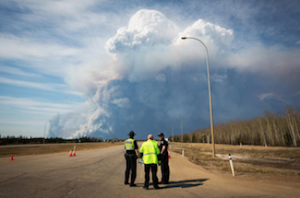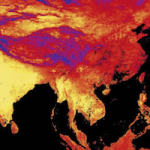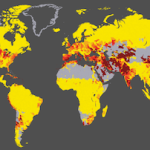May Marks 8th Consecutive Record Hot Month In NASA’s Global Temperature Measure

Source: Robert Scribbler
According to NASA, the world has just experienced another record hot month.
May of 2016 was the warmest May since record keeping began for NASA 137 years ago. It is now the 8th record hot month in row. In other words, since October, every month has been the hottest such month ever recorded (October vs October comparison, November vs November etc). And May’s record is just the most recent high mark during a period that has now vastly exceeded all previous measures for global temperature tracking.
The month itself was 0.93 C above NASA’s 1951-1980 baseline measure. It’s the first month since October that readings fell below the 1 C anomaly mark. A range that before 2015 had never before been breached in the 136 year climate record and likely during all of the approximate 12,000 year period that marks the Holocene geological epoch.
It’s a reading that is fully 1.15 C above 1880s averages. A very warm measure in its own right but one that is thankfully somewhat removed from the 1.55 C monthly peak back during February of 2016. To this point, it’s worth noting that hitting 1.5 C above 1880s temps in the annual measure is the first major temperature break that scientists consider to be seriously threatening to human civilization and the life support systems of planet Earth. And we’re getting close to that mark now. However, considering the fact that El Nino is now transitioning toward La Nina, it appears that 2016 averages may peak closer to 1.2 C.
May Was Hot Pretty Much Everywhere
Geospatially, hottest readings again centered near the Poles. Particularly, a region of the Barents Sea experienced temperatures above 4 C hotter than average for the month in the north. More disturbingly, in the south, a region of 4 to 9.4 C above average readings dominated a large zone over West Antarctica and the Antarctic Peninsula. This area is of particular concern due to numerous destabilized ice masses that are now accelerating toward the Southern Ocean and that have the ability to dramatically raise global sea levels over rather short time intervals.
(Another picture of a record warm month globally provided by NASA. This time, highest above normal temperatures centered over the near polar regions of the Barents Sea and the vulnerable and rapidly destabilizing ice sheets of West Antarctica. Image source: NASA GISS.)
Overall, extents of above average readings covered most areas of the globe. Exceptions included the North Atlantic cool pool southeast of Greenland that has been prevalent now for the better part of two years, a storm and trough related cool pool in the North Central Pacific, and storm and trough related cool zones over the Central US, Central Asia, and the Southern half of South America. Storms in these regions generated record rainfall amounts over Texas, Argentina and Russia during the month as global temperatures fell from El Nino peaks and some of the record atmospheric moisture load was wrung out.
Analysis of the May Global Zonal Anomalies Map finds that polar amplification dominated — resulting in peak temperature readings in zones near 75 North and 75 South Latitude.
(Hot poles, cooler, stormy mid-Latitudes is a sign that climate and weather impacts related to human-caused climate change are starting to ramp up. Image source: NASA GISS.)
Cooler readings in the mid 40s North Latitude and mid 50s South Latitude indicates that the climate change related deep trough zones are starting to get more fully involved (highlighted by various severe and record flooding events occurring around the world during this time).
As climate change advances and global temperatures push toward the 2 C mark, we can expect more heavy involvement in storm generation as the Poles continue to more rapidly warm and as ice sheets speed destabilization — generating the powerful regional climate variations and greater atmospheric moisture loading that greatly amps up peak storm potential energy.
Looks Like 2016 is Settling into a Range near 1.2 C Above 1880s
On the whole, the first six months of the climate year starting in December have averaged 1.36 C above 1880s readings. A strong departure that the second half of the year will almost certainly not repeat. Given current guidance along with a developing transition to La Nina, temperatures should fall into a range between 0.95 and 1.15 C above 1880s for the second half of the climate year.
A 1.2 C annual 2016 departure is firmly within the range of estimates for global temperatures that occurred within the Eemian climate period around 115,000 years ago. At that time, global ocean levels were between 16 and 25 feet higher than they are today. And if such warm temperatures continue for any significant duration, we could expect oceans to at least rise by as much (especially considering the fact that about 15-20 feet worth of sea level rise is locked into the ice of glaciers that are now in the process of heading into the global ocean).
We’re Well Behind the Curve in Providing Adequate Mitigations to a Rapidly Worsening Climate Situation
Atmospheric CO2 levels peaked at 407.7 parts per million in May as well. A jump of about 3.8 parts per million above peak readings during May of 2015. A new record that not only represents the highest levels of atmospheric carbon ever experienced by human beings (and likely the highest ever seen in the past 15 million years), but one that also marks a record rate of accumulation. A combined overburden and unprecedented rate of increase in heat trapping gasses that now represents a very serious global hazard.
If carbon dioxide levels were to remain so high we could expect global temperatures to, over the course of 300-500 years, hit near 3 C above 1880s levels and oceans to rise by as much as 60-120 feet. Adding in methane and other greenhouse gasses — current CO2 equivalent for all global heating gas estimates are now in the range of 490 parts per million. Enough to warm the Earth by about 4.6 C over hundreds of years and to, among other things, eventually raise oceans by 120 t0 200 feet.
(Record May temperatures coincided with record levels of atmospheric CO2. We haven’t seen such high levels of CO2 since the Middle Miocene Climate epoch — a period that occurred 15 million years ago. Image source: The Keeling Curve.)
Continued human fossil fuel burning makes an already bad climate situation worse. The rate of emission from human sources is probably at least ten times faster than the build-up of heat trapping gasses that set off the last hothouse mass extinction event — the PETM — about 55 million years ago. In addition, an Earth System response in the range of 10-30+ percent of the human emission each year is possible by the end of this Century. A dangerous amplifying feedback whose emergence grows more likely the longer human beings continue to add heat to the global atmosphere and ocean system.
May of 2016, therefore, is just the most recent heat record along a path toward an ever-worsening global climate situation. Current rising rates of renewable energy and efficiency adoption do provide a growing mitigation effort to combat the harmful systemic problem of fossil fuel burning and a related very high rate of human carbon emission. But the fact that we are, at best, looking at a decades-long energy transition and an eventual dropping of the human emission to near zero by 2030 to 2050, means that climate hazards will continue to rise for some time to come (an absolute practical best case will probably achieve 450 ppm CO2 and 550 ppm CO2e at peak — very dangerous levels of heat trapping gasses that we’ll want to reduce at the most rapid rates possible). In addition, serious challenges both to the rate of energy transition and carbon emissions cuts coming from various political and economic powers around the world threaten to either push the time of hitting zero carbon emissions back or to remove the possibility of such a necessary mitigation altogether.
Links:
GISS Global Temperature Analysis
Ten Times Faster Than a Hothouse Extinction
Source: Robert Scribbler











































































































































Leave a Reply